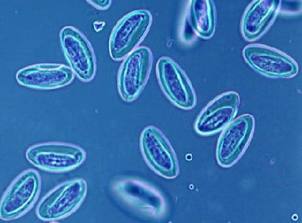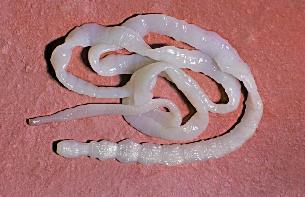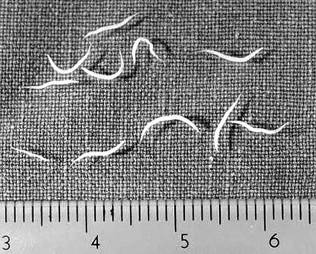
Helminthiases is one of the most common diseases among children and adults. In the human body can parasitize several species of worms. There is an opinion, far from medicine, in which the worms affect the digestive tract, in fact, worms can parasitize virtually all internal organs – liver, lungs, heart, brain, head, and muscle tissue, the subcutaneous tissue and in the eye. The article talks about how there are worms in humans.
Classification
There are a large number of worms that can affect man, some of the most common of them. Most worms belong to any of the 3 groups, trematodes, cestodes or nematodes.
Flukes are a class of worms parasites flat forms, there are about 40 species of worms that affect man. The most common:
- cat or Siberian Fluke (causes opisthorchiasis);
- Schistosoma (causing schistosomiasis).
Cestodes tape worms is flat. The representatives of the cestodes is not the digestive system. The greater part of the man are amazing:
- beef tapeworm (beef tapeworm infection causes);
- the pork I had (cause of cysticercosis);
- Echinococcus (hydatid cyst causes).
The Nematoda is roundworms, which is primarily abdominal. Common helminth affecting humans:
- pinworms;
- roundworm;
- the whipworm.
Worms in humans — signs in the photo (the majority of the worms affect the digestive tract, therefore, nausea and vomiting, diarrhea or constipation, intestinal obstruction, unexplained weight loss, lack of appetite or excessive appetite):
Cat or Siberian Fluke

Cat or Siberian Fluke – a small parasite lanceolate group of liver flukes. The causative agent of the disease opisthorchiasis. A length of cat Chance arrives 8-18 mm in width and 1.2-2 mm. the Parasite develops in the body of the two machines, both intermediate and final. Intermediate hosts – molluscs and fish in the tent, the last man.
Along with the faeces of infected people and animals, the eggs get into freshwater reservoirs, where they eat seafood. In the body of a mollusk eggs reach the infective stage – cercaria, cercaria leave the mollusk and implanted in the body of cyprinid fish or get into their bodies by eating fish and seafood. In the body of the fish, the parasite develops in the meta-cercaria in the cyst, its size reaches about 0.17-0.21 mm.
At the time of eating contaminated fish infected people, your body meta cercaria leave the cysts of the stomach and of the intestine, which pass into the liver and bile ducts. In these organs are kept parasite, and 10-12 days to reach the Maturity stage, begin to lay eggs. In the human body cat Fluke can parasitize up to 10-20 years.
Shistosoma
Schistosoma – blood flukes. It is a flat dioecious helminths, has a length of 4-20 mm, width – 0.25 mm. Body shistosoma equipped with 2 children – oral and ventral, which are located close to each other. The females of Schistosoma more and more slim than males. In the body of the male has a groove longitudinal, which has the woman. Their eggs are 0.1 mm in diameter, in oval shape, on the surface of one of the poles is a great pic.
Human worms Schistosoma in the role of the final host choice of the people in their bodies, that parasitize in the small veins of the colon, abdominal cavity, uterus, bladder. Worms feed on blood, partly absorbed nutrients through the cuticle. Eggs Schistosoma transported to the intestine and bladder, where Mature and are eliminated with feces or urine. In the fresh waters of the egg comes out the larva, its intermediate hosts – mollusks. In the body of the mollusk meta cercaria cercaria develop in 4-8 weeks.
Beef had

Beef had band parasite that causes the disease of beef had the infection. This is a large helminths, are able to grow to 3-12 meters long. In the body of the parasite is a small head with a diameter of 3 mm, the neck, and about 1000 segments. After entering the human body along made with meat infected, the tapeworm attaches to the intestinal wall with the help of 4 suction cups.
In hermaphroditic segments are deposited the eggs of the helminth, annually, an individual sets up to 600 million eggs. Like worms in humans, parasitic in the intestine of 20 years or more, if there is no timely treatment.
Pork had
Pork was bullish, the body has 4 children, but in addition the body of the helminth has a dual rim hooks. Reaches two to three meters in length. Have a pig had before of the ovary, with each side of the uterus has 7 to 12 branches. A characteristic feature of helminth – ability of the segments crawl out of the anus. After the release of his shell is dry and the winds, so that the external environment are helminth eggs. Intermediate host tapeworm can be pigs and people.
The main host was a man. Intestinal parasites in humans include the pork tapeworm, is a helminth in the intestine of the patient, where he gets his eggs. The infection occurs in the use of invasive meat.
Echinococcus
The causative agent of echinococcosis in length reaches 3-5 mm. It consists of a chief, who has four children and two rim hooks, and three or four segments. The last of the segments has developed a reproductive system. Intermediate host – cattle or people, the end of the host – dog, wolf. The infection occurs by the oral route.
Echinococcus enters the intestine where eggs emerge the larvae. With the help of hooks of the larvae, penetrate the portal vein, where along with the blood, spread to the liver, lungs, muscle tissue.
Pinworms

Pinworms – worms, enterobiasis pathogens, the so-called disease of dirty hands. To a greater extent pinworm infection-prone children. The infection occurs orally and by contact-household. To detect these worms in the stool.
Females helminths pinworms of the genus reach a length of 5-10 mm, men – 3 mm. The shape of the body has pinworms fusiform milky white. At the end of the body of the females are slightly pointed. Adult worms are parasitic in the lower small intestine and colon of man, which is attached to the wall with a head vesicles. In order to lay eggs, the female pinworms pass to the rectum, crawl and lay eggs in the area anal, then die. Their eggs become infectious after 4-6 hours. The duration of the pinworm life – one to two months.
Roundworm
Roundworm, and even some representatives of the class of worms, parasites, the causative agents of ascariasis. This is the helminths yellowish – pink colour, have an elongated, in the form of a spindle, dioecious. Female ascarids grow up to 20-40 cm, males reach a length of 15-25 centimeters. Each day an adult female roundworm lays more than 200 thousand eggs, which, together with the stool of a person released into the environment, where after 12-14 days become invasive.
In the human body parasites in the gastrointestinal tract, is localized mainly in the small intestine. The full cycle of development of the infective eggs to Mature stage takes about 3 months.
Whipworm
Whipworm – round worms, causing trihozefalez. The worms are a fine brown color with a thin, threadlike anterior part and a rounded posterior end. Female whipworm grow 3.5-5.5 inches, and men up to 3-4,5 cm. The larvae of the worms humans are localized in the caecum, where and are the parasites of the puberty stage, there lay their eggs. With a massive invasion of helminths can also take the colon, including the rectum.
Each day of the female whipworm lays 3,5 thousand eggs. Helminth eggs have a barrel shape, covered with a thick brown shell, the dust are colorless "heads". The eggs enter the soil, together with the faeces of the primary host, under conditions favorable to keep the invasive properties of up to two years. Duration of parasitism in the intestine of humans is 5-7 years.






































